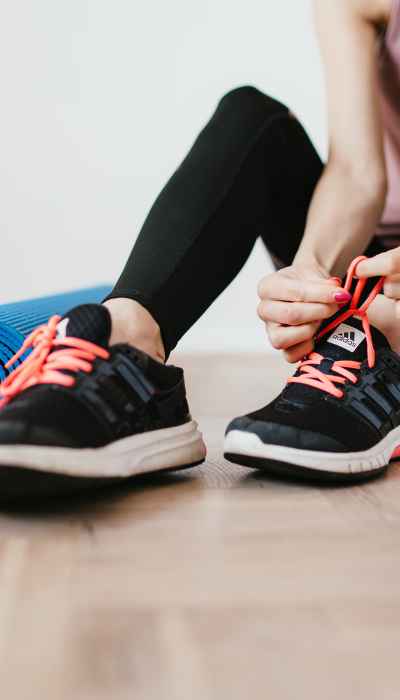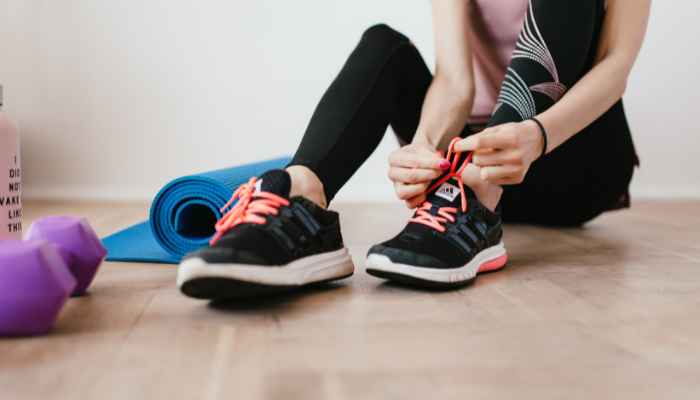Last Updated on February 16, 2025


During these challenging times that we’re facing today, we must find ways to stay fit. Given the global COVID-19 pandemic, this is not just for aesthetics. Overall health and longevity are of primary concern. Unfortunately, a major risk factor is people only getting their physical activity by being out and about. I’m here to tell you that is equally possible indoors.
One of the best ways to do that is to perform cardio at home. Among other at-home exercises that are usually quite simple, at home cardio can be pretty fun too.
Things like P90X, Insanity and even Taebo have had a lot of success. They are all primarily cardio workouts that you can do from anywhere as long as you can view the content. Cardio at home has become increasingly feasible with the emergence of personalized online training.
With this style of guidance, online trainers can notably increase your competence. They can also give you a variety of different cardio workouts to perform at home. First, however, it’s important to note that there are two types of cardio.
One type of cardio is what’s known as long duration, low-intensity steady-state cardio or LISS. The one major issue we have with LISS is that it takes much longer time frames than other forms of cardio, such as high-intensity interval training (HIIT), which seems to be a popular workout routine these days.
Both are great for burning calories, improving cardiovascular endurance, breaking a sweat, and getting a great overall workout. However, cardio is meant to challenge your heart more than challenge the actual skeletal muscles themselves. If your focus is longevity, however, then that’s still an important route to go with your exercise routine.
Fortunately, I’m going to show you three super simple cardio exercises. The best part: is you can do these by yourself at home without any equipment!
Cardio at Home: Mountain Climbers – Lower Body
One of my favorites is a very simple exercise called the mountain climber. The reason this is so effective is that you do not need any equipment. Instead, you can simply use your weight. First, you need to get into a push-opposition: place your hands on the ground directly below your shoulders (maybe a few inches outside of your shoulder frame) and get up onto your toes as you’re facing the ground. Whenever you’re ready, simply bend your knees and hips as if you are jogging in place.
The key is maintaining a solid torso while you’re doing this. Otherwise, you can notice some back pain due to excessive forward curving (or lordosis) in your lower back (or lumbar spine). When this happens, it means your abdominal region is not quite as engaged as it should be to maintain your spine in a neutral position. Therefore, regress to a normal plank position without the leg motions first.
Another option would be to place your hands on a taller, stable object like a couch, countertop, or bench. By doing this, you will take a significant amount of pressure not only off your torso (in keeping the neutral spine position) but your arms as well. The same leg motion would take place with your hands on the higher surface.
Cardio at Home: Shadow Boxing – Upper Body
Another great exercise is called Shadow Boxing. Essentially, you’re pretending to be a boxer swinging at an opponent in front of you at a fast rate. This form of upper-body cardio is particularly good for anyone who has had previous issues with lower extremity joints.
Not to mention that this could be a great alternative, at home cardio workout for those who suffer from osteoarthritis (especially the elderly), as it takes the pressure off those lower extremities.
Finally, I think it goes without saying, BUT if you’re in a crisis and need to fight your way out, you have a better chance of winning an altercation if your cardio of choice is shadowboxing rather than mountain climbers!
Cardio at Home: Swimmers – Midsection
The last form of cardio exercise that I enjoy is unlike all the rest: they’re called swimmers. First, you lie on your stomach with your legs and arms outstretched. After that, lift opposite extremities (left/right & upper/lower) at the same time as though you’re swimming. This exercise largely depends on your effort for how much cardio you can achieve. Ideally, you want to raise your heart rate for a sustained period
However, this exercise is especially important because it utilizes postural muscles that rarely are the focus of a workout routine. Typically, people neglect the mid and lower back regions in their daily exercise.
This is a great way to not only get some cardio workouts in at home but ALSO to do upper-body cardio workouts without any equipment. Another bonus is that it puts no impact on the joints, making it safe for all ages to perform. One key thing to watch for: makes sure you can safely return to a standing position from lying on the floor.
Conclusion
So I have gone over three pretty different at-home cardio workouts. They are especially handy if you are in a situation with zero equipment options, have achy joints, or just want to individually target your upper, middle, and lower body regions.
The key here is that you want to elevate your heart rate while doing these exercises for a sustained period It’s also important that you check your heart rate before, during, and after a workout. This is to assess that you’re not only being safe but also raising your heart rate. I typically recommend that my clients spend 20 minutes doing low-intensity cardio for a session to see a significant number of calories burned along with a moderate rise in heart rate. Remember, however, that ideal cardio for one person may not be ideal cardio for another (i.e. a professional athlete).
On the other hand, if you’re performing high-intensity cardio, then you would simply reduce that to 6-10 minutes and increase the intensity at which you perform the motions. Again, I would recommend checking your heart rate before, during, and after high-intensity cardio for the best results.
In closing, this is understandably a difficult time for many people. Many options for exercise have been taken away due to the pandemic we are facing. However, it’s important to focus on your end goal. Remember to utilize all options so that when everything has returned to normal, you don’t feel like you’re starting your fitness journey all over again.
I wish you the best of luck and hope that this article can help you stay healthy and on track to reach your final goals. Ultimately, it’s equally important to have fun and stay well so that your fitness and wellness journeys can coalesce into you becoming the best version of yourself.
Which cardio burns the most fat?
The activity that burns the most calories per hour is running. Swimming, walking, and stationary bicycling are other fantastic possibilities. HIIT workouts are excellent for calorie burning. Your body will continue to burn calories for up to 24 hours after an HIIT workout.
What do 10 minutes of cardio do?
improved cardiovascular health
Exercises as brief as 10 minutes can improve oxygen uptake, a metric for endurance and cardiovascular fitness.
Are 20 minutes of cardio effective?
Yes, 20 minutes of activity every day is preferable to none. Every physical activity or exercise session makes you fitter, healthier, and probably happier.
Here are a few hand-picked articles for you to read next:
- Complete At-Home HIIT Workouts for Women for Sustainable Weight Loss
- 7 Simple Bodyweight Back Exercises for a Healthier, Sexier Back
- How to Create a Convenient Home Workout Plan That Works for You
Tyler Guzzo is the creator and driving force behind Guzzo Fitness Systems. With roots in physical therapy and personal training, Tyler has spent over a decade helping clients reclaim their health, confidence, and vitality. A former clinic and gym trainer, he turned his passion into a thriving coaching business—now serving clients nationwide through online programs and virtual boot camps. Tyler’s expertise lies in crafting individualized fitness and nutrition strategies, offering vibrant live classes, and building strong accountability communities. His empowering approach is especially impactful for busy professionals and moms, focusing on sustainable habits and real-world results. Beyond fitness, Tyler is known for giving back through charity-driven fitness experiences that benefit his local Florida community.
- Tyler Guzzohttps://successiblelife.com/author/tyler-guzzo-certified-personal-trainer/
- Tyler Guzzohttps://successiblelife.com/author/tyler-guzzo-certified-personal-trainer/
- Tyler Guzzohttps://successiblelife.com/author/tyler-guzzo-certified-personal-trainer/
- Tyler Guzzohttps://successiblelife.com/author/tyler-guzzo-certified-personal-trainer/
